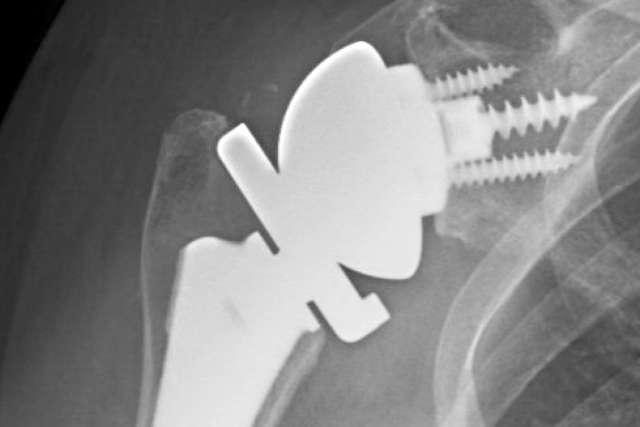As the U.S. population ages and the technology advances, joint-replacement surgery has become an increasingly appealing option for individuals looking to reduce pain and regain function by substituting manufactured devices for frayed or otherwise damaged bones. While more people are familiar with knee and hip replacements, shoulder-replacement surgery is an equally safe and effective treatment for individuals who are unable to find relief from non-surgical approaches, says Andrew Jensen, MD, MBE, a UCLA Health orthopaedic surgeon who specializes in primary and revision shoulder and elbow surgeries.
“A large number of people are affected by the conditions that these surgeries are designed to benefit, and shoulder replacement now has wide applicability,” Dr. Jensen says. While many people’s discomfort can be sufficiently addressed with physical therapy, non-narcotic medications or steroid injections, “for those who are still experiencing severe pain or discomfort that interferes with their sleep, work or ability to enjoy their hobbies, shoulder replacement is a reasonable step.”
“A large number of people are affected by the conditions that these surgeries are designed to benefit, and shoulder replacement now has wide applicability.”
He explains that the most common condition leading people to seek a shoulder replacement is pain from osteoarthritis — a degeneration of the joint that typically worsens with age — or the wear and tear associated with high-intensity sports or physical labor. Other conditions include traumatic injury or fracture, rheumatoid arthritis (in which the immune system attacks the joints) or cancer.
The typical surgery for these patients — assuming they have no damage to their rotator cuff tendons — is an anatomic shoulder replacement, which replaces damaged portions of the shoulder joint with prosthetic parts. If the rotator cuff muscles are torn or degenerated, a reverse shoulder replacement is performed, in which the new ball of the shoulder is placed on the socket side of the joint, while the socket is placed on the outside. This approach restores movement to the shoulder through the deltoid muscle when the rotator cuff has lost function.
The majority of patients who undergo shoulder replacement are able to return home the same day. Postsurgical pain can be reduced with a regional block to numb sensation in the shoulder for the initial recovery period. Following surgery, patients must wear a shoulder immobilizer for two-to-six weeks, during which time they begin working with a physical therapist to optimize their recovery.
Dr. Jensen notes that both the anatomic and reverse shoulder-replacement surgeries have undergone significant improvements over the years, with smaller and more effective implants, along with advances in surgical technology to reduce the invasiveness of the procedure and improve outcomes. UCLA, which performs a higher volume of shoulder-replacement surgeries than most institutions, has been at the forefront of those advances.
“More than anything else, this surgery is very good at alleviating pain in the vast majority of patients,” Dr. Jensen says. “In addition, nearly everyone has more range of motion than they had before surgery, and approximately 80% are able to participate in a sport they couldn’t participate in before due to their shoulder pain. Overall, most of our patients are extremely happy with the results.”

